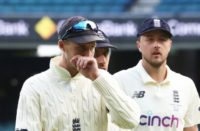Every cricketer with a lengthy career will experience dips in form, but AB de Villiers appears to be battling more than a crisis of confidence in his batting. It is often said of the best players that their biggest opponent is themselves, but it is as if De Villiers, a cheerful, upbeat character previously, has suddenly discovered a cupboard full of skeletons.
It is not just his form in the current Champions Trophy, either, poor though that has been. I commentated on several Indian Premier League matches in which he was playing for Royal Challengers Bangalore and he did not seem switched on at all. For someone who was such a brilliantly instinctive batsman it was like a innate power, such as his overwhelming desire to seek a challenge and fashion victory from any situation, had been removed.
Now, it is damned hot in India at that time of year but even so, for such a committed cricketer, he seemed to be away with the fairies.
He has clearly felt the change, for his two innings so far in this tournament have smacked of desperation in the naive way he has tried to hit his way back into form. While there is no doubt that feeling a good connection off the middle of the bat can lift spirits, you have to select the right ball to clobber. So far, his miscued pull against Sri Lanka, which lobbed to cover, and his airy scythed drive to backward point against Pakistan, which sent him back for his first golden duck in one-day internationals, have been pure hit and hope.
His captaincy of South Africa’s Test and one-day team, which he cherished when they were first bestowed, has been under scrutiny for a while, something not helped by Faf du Plessis’ growing reputation as an astute tactician and man-manager.
Leading South Africa comes with political interference from above, especially in team selection, which has transformation quotas on race to satisfy. In the Test series against England 18 months ago, De Villiers had to keep wicket as well as bat and captain in order to balance the side, racially. It was an extra role he clearly did not care for, given his comments in the Press about possible retirement from that format.
Instead, he took a prolonged rest, though tellingly for some, not from IPL. His sabbatical, which continues after the Champions Trophy so he will not be playing the Test series against England this summer, allowed Du Plessis to come in and oversee a Test series win against Australia. It was a fine victory made more remarkable for it being away from home and achieved without South Africa’s three truly world-class players, De Villiers, Dale Steyn and Morne Morkel.
Du Plessis has enjoyed the Midas touch when he has led the one-day side as well, his nine matches in charge leading to eight wins and one one-day defeat including five successive victories against the Aussies.
With him hovering like Banquo’s ghost, extra scrutiny has been placed on De Villiers’ leadership, most recently in the defeat by Pakistan at Edgbaston on Wednesday. Aside from the mercurial qualities of a Pakistan side which can veer between hot and cold like a defrosting vindaloo, De Villiers’ critics have accused him of being too slow to make the right bowling changes in a game that was always likely to be decided by Duckworth/Lewis.
While I feel De Villiers’ own travails have somehow transmitted to the team, who appeared nervy when batting first against an improved but hardly devastating Pakistan bowling performance, his bowling changes prior to play being halted due to rain, such a slating was harsh.
Indeed, he used Morkel well to strike at Pakistan, the bowler taking three wickets in his two spells. Had Kagiso Rabada not been out of sorts, or Wayne Parnell’s opening spell so savaged by Fakhar Zaman, South Africa might have been ahead on D/L when rain came in the 28th over.
Where criticism is perhaps deserved, it is not in failing to bring back Imran Tahir who would have to contend with a damp and therefore slippery ball, but in altering the plan of attack to new batsman Shoaib Malik. Instead of continuing Morkel’s targeting of Malik and Babar Azam’s ribcages, with a leg gully and two men on the hook to take advantage of any mistakes, De Villiers got Morkel to shift his line to off-stump and just outside.
Like many decisions in white-ball cricket it was a gamble to take wickets, presumably from an edged catch given Hashim Amla’s presence at slip.
The only problem was that Morkel was dialled in to a bang-in length which had worked well when directed at the batsman’s body, but which now, with the shift in line, handed Pakistan boundary opportunities which they took with some savage cut shots. With Rabada conceding fours at the other end, Pakistan were able to get ahead of the D/L par score just before persistent rain concluded the issue.
By the standards of most captaincy errors it was small beer, though you can see it growing into a bad hangover for De Villiers should South Africa fail to qualify for the semi-finals – a very real prospect if they lose to India on Sunday and Pakistan win their final group match against Sri Lanka.
This piece originally featured in The Cricket Paper, June 9 2017
Subscribe to the digital edition of The Cricket Paper here












